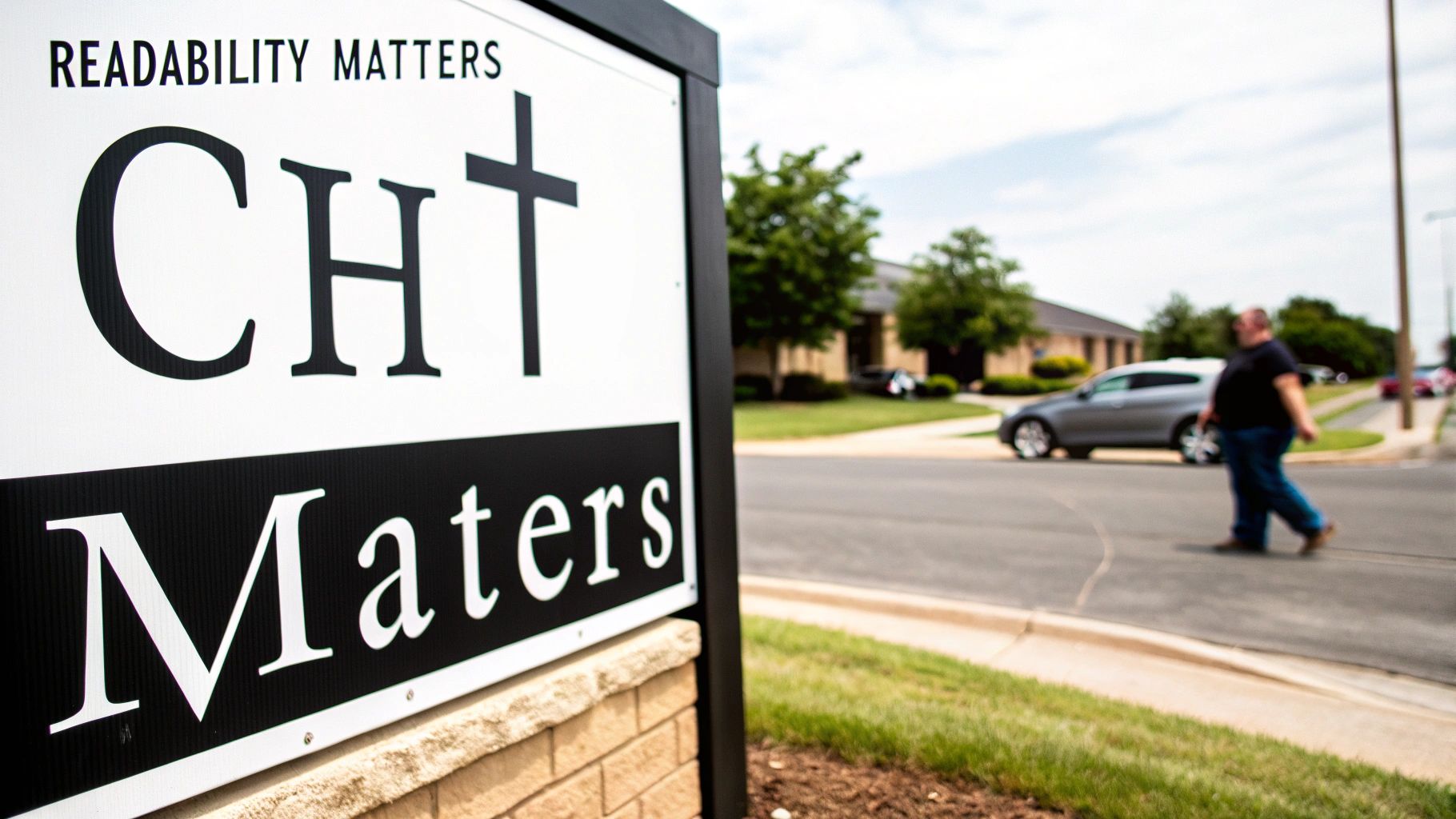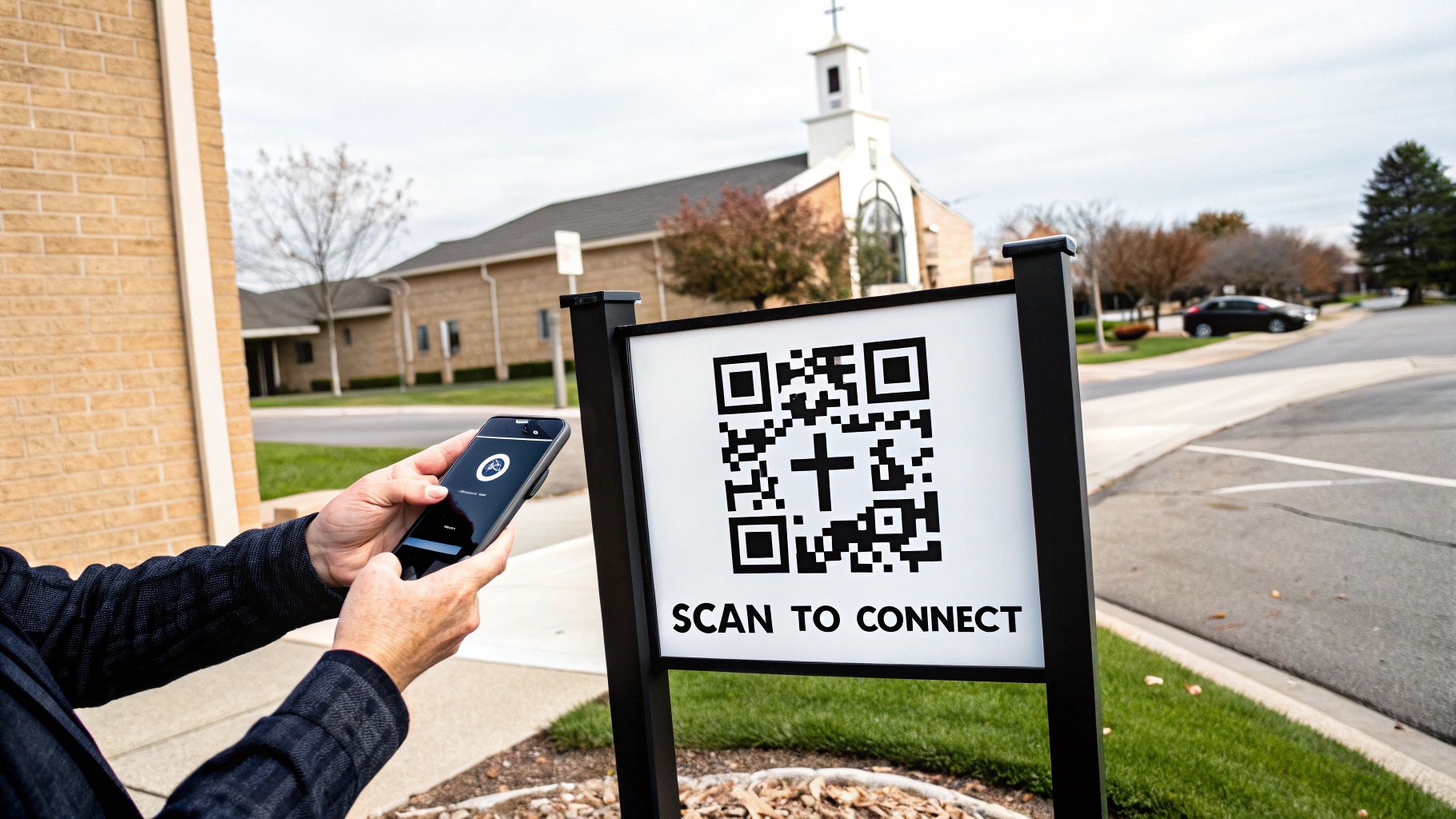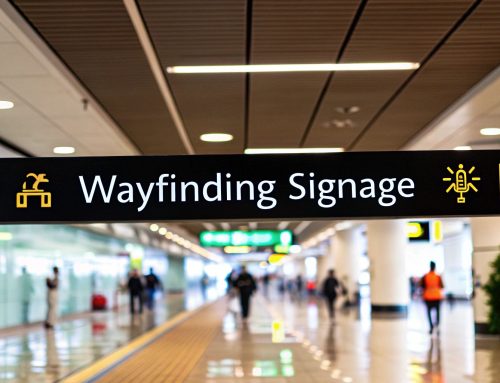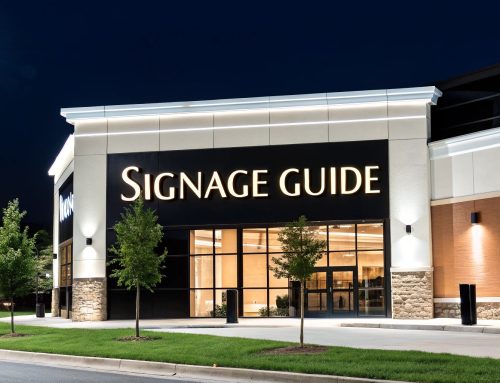A modern church sign is the first handshake your ministry offers the community. It's so much more than a place to list service times. It's a conversation starter, a reflection of your church’s heart, and a welcome mat for everyone who drives by.
Why Your Church Sign Is More Than Just a Sign
In a world overflowing with digital ads and online noise, the physical sign outside your building has become one of your most powerful tools for making a real first impression. The job of a church sign has completely changed. What used to be a simple bulletin board is now your best opportunity to build community right from the curb.
This isn't just a minor update; it's a fundamental shift in how churches communicate with their neighborhoods. The goal is no longer just to broadcast information but to create genuine connections. A truly effective sign does a few things really well:
- It Sparks Curiosity: A clever or thought-provoking message makes people slow down and see your church in a new way. For example, a sign that asks, "What if you woke up today with only what you thanked God for yesterday?" can make a driver pause and reflect.
- It Shows Who You Are: The design, the materials, and the tone of your messages all tell a story about your church's personality—whether it's traditional, modern, or family-first. A solid stone monument sign conveys permanence, while a bright digital sign signals an active, event-driven ministry.
- It Offers a Little Hope: You never know who's having a tough day. A simple, encouraging phrase can be a small beacon of light. A message like "Your future is not your past" can offer a moment of comfort to someone who really needs it.
A Critical Tool for Community Connection
Getting intentional with your signage has never been more important. The reality is that the landscape for churches is shifting. Data shows that in the U.S. alone, somewhere between 4,000 and 10,000 churches close their doors annually. Before 2020, only about 3,000 new ones were being planted each year. These numbers highlight just how critical it is for churches to be proactive in their outreach if they want to remain a vital part of their community. You can dig into these church trends to understand the full picture.
Your sign is the "front door" to your ministry. It's often seen by more people in a single day than will visit your website in an entire week. Think of it as a silent ambassador, working 24/7 to share your message of welcome.
A modern sign isn't just about buying an LED display; it's about adopting a new mindset. It’s about purposefully engaging with the world just outside your walls and making an impact that starts the moment someone drives past.
Choosing the Right Type of Modern Church Sign
Picking the right sign for your church is a big decision. It’s a delicate balance between your message, your budget, and the architectural style of your campus. This goes way beyond just aesthetics; you're choosing the most effective tool to communicate with every single person who passes by your doors.
Think of it like a musician choosing an instrument. A traditional sign is like an acoustic guitar—it's timeless, reliable, and perfect for delivering a clear, simple melody. A digital sign, on the other hand, is like a full keyboard synthesizer—versatile, dynamic, and capable of playing a different tune every hour. Both can create beautiful music, but they serve very different purposes.
Traditional Signs with a Modern Twist
Modern doesn't always have to mean digital. Many churches are making a powerful and elegant statement by updating classic sign structures with contemporary design elements. These signs lean into clean lines, minimalist fonts, and high-quality, durable materials that feel like a natural extension of the building itself.
One of the most popular and impactful options here is the monument sign. These are low-profile, architectural structures, often built from materials like stone, brick, or metal that create an immediate sense of permanence and stability. To get a better feel for their construction, you can learn more about what a monument sign is and see how it works with the surrounding landscape to create a truly welcoming entrance. They are simply fantastic for establishing a strong, lasting presence in the neighborhood.
The infographic below breaks down how any great sign fulfills three core actions: communicating, connecting, and welcoming.
This visual makes it clear that no matter which type of sign you choose, it has to nail these fundamental goals to effectively serve your ministry.
Modern Church Signage Comparison
To help you visualize the options, this table compares some of the most common sign types available to churches today.
| Sign Type | Key Features | Best For | Budget Level |
|---|---|---|---|
| Digital LED Signs | Dynamic, easily updated content; high visibility day and night; programmable. | Churches with frequent events, announcements, and community outreach. | High |
| Monument Signs | Permanent, architectural feel; durable materials like brick, stone, or metal. | Establishing a strong, lasting presence and enhancing property value. | Medium to High |
| Changeable Letter Signs | Manual letter tracks; classic, nostalgic look; budget-friendly. | Churches needing simple, infrequent message changes on a tight budget. | Low |
| Backlit Cabinet Signs | Internally illuminated box sign; clear visibility at night. | Identifying the church name and location, especially after dark. | Medium |
Each of these options offers a unique way to connect with your community, so the best choice really hinges on your church's specific communication needs and budget.
The Power of Dynamic Digital Displays
For any church with a busy calendar and a steady stream of events, a digital LED sign offers flexibility that’s simply unmatched. Being able to change your message in an instant from a computer means you can promote this week’s sermon, next month’s food drive, and an urgent prayer request all in the same day.
It's a powerful tool for perception, too. A staggering 68% of consumers believe a company's signage reflects the quality of its products or services. A crisp, bright, and current digital sign tells your community that your church is active, relevant, and deeply engaged.
This real-time capability transforms your sign from a static bulletin board into a dynamic community hub. As you weigh your options, it's worth taking the time to explore modern LED display options to see just how far the technology has come in screen resolution and user-friendly software.
Ultimately, the best choice is the one that authentically reflects your church’s unique identity and mission. A simple, beautifully designed architectural sign can convey peace and stability, while a vibrant LED display communicates energy and constant activity. The key is to choose the sign that tells your story best.
Design Principles That Make People Look Twice
A great sign is all about smart design, not just pretty decoration. After all, a beautiful sign that nobody can read from the road is just an expensive piece of art. The best modern church signs are built on a foundation of core principles that put clear communication first.
Think about it: your sign has just a few seconds to grab the attention of someone driving by. In that tiny window, the design has to make an instant connection. This is where the old saying "less is more" really hits home. A clean, uncluttered layout gives your message room to breathe and stand out.
Readability Is Your Top Priority
Before you get attached to a specific font or color palette, you have to test for readability. The average driver has maybe three to five seconds to read and understand your sign. Your message needs to be crystal clear, both from a distance and while in motion.
Here’s a simple trick: try the "squint test." Stand back from your design proof and squint your eyes. Does the main message blur into the background? If so, you don't have enough contrast. A good sign has to work just as well in the bright morning sun as it does in the dim light of dusk. A practical example is using dark letters (like black or deep blue) on a light background (like white or cream), or the reverse. This high-contrast combination is almost always easier to read at a glance than subtle, low-contrast color schemes.
Key Takeaway: If a driver has to struggle to read your sign, you've already lost them. The goal isn’t just to be seen; it's to be understood in a single, effortless glance.
Choosing Fonts and Colors That Reflect Your Church
The fonts and colors you pick do more than just look nice—they tell a story about your church's personality. They create a feeling before a single word is even read. A solid handle on graphic design for church principles is what separates a forgettable sign from one that genuinely connects with people.
Your font choice is a huge part of that story. Does your church feel more traditional and established, or is it energetic and modern?
- Serif Fonts (like Times New Roman): These have small finishing strokes on the letters and tend to feel classic, formal, and authoritative. They work well for churches with traditional architecture and a more formal worship style.
- Sans-Serif Fonts (like Helvetica or Arial): These are clean, without the extra strokes, which gives them a modern and approachable vibe. They're almost always easier to read from a distance, making them a safe and effective choice for most outdoor signs.
Remember, when you’re creating a physical sign, that typeface is a permanent decision. It's worth exploring different fonts for metal signs to see which styles hold their own in an outdoor setting. The right font ensures your sign is both stylish and functional for years to come.
Crafting Messages That Connect and Inspire
The hardware and design of your church sign are the body, but the message is its voice. A great sign does more than just list service times; it starts a conversation with the entire community. The real goal is to write messages that make people curious, offer a quick dose of encouragement, or simply make them feel seen.
This means you have to move past formal announcements and embrace short, memorable, and often thought-provoking phrases. Remember, you only have a few seconds to catch the eye of someone driving by. This brings us to the "five-second rule"—if your message can't be read and fully understood in five seconds flat, it's too complicated.
From Information to Inspiration
The best messages often take timeless truths and give them a modern twist. There’s a powerful trend toward witty, catchy, and culturally relevant phrases that connect with everyone, not just churchgoers. For instance, Christ Moravian Church in Calgary got noticed for creative signs like “iPad? iPod? try iPray!” and a viral winter message that read, “Whoever is praying for snow, stop praying!” Messages like these start conversations and show your church has a personality. You can read more about the revolution of church signs and their messaging to see just how effective this can be.
A sign's message should act as a bridge, not a barrier. It's an opportunity to offer a moment of hope, humor, or reflection to a neighbor you may never meet otherwise.
The most effective messages tend to fall into a few key categories:
- Hope and Encouragement: Think simple and uplifting, like "Broken crayons still color" or "Worry ends where faith begins."
- Gentle Humor: Playful but meaningful quips such as "God wants full custody, not just weekend visits."
- Thought-Provoking Questions: Posing questions that make people pause, like "What if you woke up today with only the things you thanked God for yesterday?"
Brainstorming Your Next Message
When you're brainstorming, think about what's happening right in your own neighborhood. Is there a big high school football game this Friday? A local festival? A heatwave? Tying your message to shared local experiences makes your church feel grounded and part of the community's daily life. A practical action step is to hold a brief monthly meeting with a few creative volunteers to brainstorm sign messages relevant to the upcoming season, local events, or sermon topics.
Above all, your message must be welcoming. Use language that speaks to universal human experiences—hope, struggle, joy. Stay away from insider jargon or specific references that only your current members will get. You want every single person who drives by to feel like you're speaking directly to them.
Ultimately, getting the message right is one of the most powerful business signage ideas a church can use. It turns a static sign into a warm, dynamic voice for your ministry.
Connecting Your Sign to Your Digital Ministry
A modern church sign should do more than just announce service times. It needs to be the physical handshake that invites people into your digital ministry. Think of your sign as the front door and your online presence as the rest of the house—the two have to feel connected to create a seamless, welcoming path for anyone curious about your church.
This is all about creating a consistent identity. The colors, fonts, and even the tone of your message on the sign should feel instantly familiar when someone lands on your website or social media. When it all lines up, you build trust and show that your church communicates with purpose, both on the street and online.
Bridging the Physical and Digital Divide
The real goal here is to use your sign to point people directly to your digital platforms. Hundreds, maybe even thousands, of people drive by every day. Most of them will never think to search for you online, but a well-placed prompt on your sign can change that. You're building a bridge, inviting them to take the next step from the comfort of their own phone.
This isn't just a nice idea anymore; it's essential for outreach. Since 2020, technology has become a core part of how churches operate, with a staggering 96% of U.S. Protestant pastors now streaming their services. That shift means your sign has to work just as hard for your online community as it does for your local one.
Actionable Ways to Connect Your Sign
Making this connection happen is simpler than you might think. Here are a few practical strategies you can use right away:
- Showcase Your Digital Front Door: Always include your website address and main social media handle. Keep them clean, simple, and easy to remember.
- Sync Up Your Sermon Series: Use your sign to tease the title or a key question from your current sermon series. It creates a natural hook, encouraging people to check it out online. For instance: "This Sunday: Finding Peace in a Busy World. Watch live at YourChurch.com."
- Use QR Codes with a Purpose: A QR code shouldn't just go to your homepage. Link it directly to a specific action, like an event registration page, a welcome video from your pastor, or your online giving portal. If you're promoting a food drive, the QR code should take users directly to the page with all the details and volunteer sign-up form.
When you link your physical sign to your digital ministry, you multiply its impact. Every message becomes an invitation to connect on a deeper level, turning a quick drive-by glance into a potential long-term relationship.
This unified approach makes sure your message reaches people no matter where they are. Whether you’re using a classic monument sign or a high-tech screen, this strategy turns it into a powerful tool that serves your community 24/7. To get a better handle on the technology behind these displays, check out our guide to digital and LED signs.
Your Step-By-Step Plan for a New Sign Project
Taking on a new sign project feels like a huge task, but when you break it down into smaller, manageable steps, the whole process becomes much clearer. Think of it like building a house—you’d never start putting up walls without a solid foundation. This plan is your foundation, guiding you from that first spark of an idea all the way to the final installation.
Your first move is to pull together a dedicated project team. A small group of two to three people from your leadership or building committee is perfect for this. Their main job is to get crystal clear on the project's goal. Are you trying to boost your visibility from the street? Announce events more effectively? Or simply create a more welcoming first impression for newcomers?
Define Your Scope and Budget
Once you know why you need a new sign, the next step is figuring out a realistic budget. This is about more than just the price tag of the sign itself. You need to account for potential installation fees, any electrical work needed for illuminated or digital signs, and even landscaping to make sure it all looks right.
It’s also smart to think about long-term maintenance costs. A digital sign, for instance, will need software updates and maybe some tech support down the line. A traditional monument sign might just need a good cleaning every now and then or minor repairs. Factoring these things in from the start saves you from surprise costs later.
A well-planned budget is the single most important tool for a successful sign project. It keeps your vision grounded in reality, preventing delays and compromises on quality when it matters most.
Navigate Regulations and Find a Partner
Before you get too attached to a specific design, you absolutely have to understand your local zoning laws. Every city has its own rules about sign size, height, placement, and lighting. Digging through these regulations can feel like a chore, but it's a non-negotiable step. To make this part easier, you can learn more about how to handle sign permit requirements and keep your project on track and fully compliant.
With a good handle on the rules, you’re ready to find a reputable sign company to partner with. Look for a company that has a strong portfolio of projects similar to yours and isn't shy about sharing client testimonials. The right partner won’t just build a sign; they’ll guide you through everything from material selection and design to fabrication, helping turn your vision into a physical reality.
Your Top Questions About Modern Church Signs Answered
When it's time to invest in a new sign, church leaders often run into the same practical questions. Let's clear up some of the most common ones so you can move forward with confidence.
How Much Should We Budget for a New Sign?
This is the big one, and the honest answer is: it depends entirely on what you need. A high-quality, traditional sign might run a few thousand dollars, while a large, full-color digital LED display can easily be $20,000 or more.
The price tag is really shaped by a few key things:
- Size and Complexity: Bigger signs with custom architectural elements are going to cost more than a simple post and panel.
- Materials: A beautiful stone or brick base with high-grade aluminum letters is a bigger investment than simpler materials.
- Technology: Adding digital displays or internal lighting is where the cost can jump up significantly, but so does the impact.
Your best bet is to get a few quotes from reputable sign companies. It's the only way to really compare your options apples-to-apples.
How Do We Navigate Local Sign Regulations?
Before you fall in love with a design, you absolutely have to check with your local city or county government about their zoning ordinances. These local laws control everything—how tall your sign can be, its total square footage, where it can be placed, and even how bright it can shine at night.
The best strategy here is to work with an experienced sign company. They deal with these codes every day, know how to handle the permitting process, and will make sure your new sign is completely compliant. It saves you from headaches, delays, and potential fines down the road.
What Maintenance Does a Digital Sign Require?
Modern digital LED signs are built tough, but a little upkeep goes a long way in protecting your investment. Think of it like basic maintenance on a car. You'll want to gently clean the screen to keep it free of dust and grime, run software updates when they're available, and make sure the vents are clear so it doesn't overheat.
When choosing a sign, look for a manufacturer that offers a solid warranty and has a reputation for good customer support. That way, if any technical glitches pop up, you have a partner ready to help you get back up and running.
Ready to create a sign that welcomes your community and reflects your ministry's heart? The team at On Display Signs, Inc. manages every step of the process, from design and permitting to fabrication and installation. Visit us online to start your project today!







